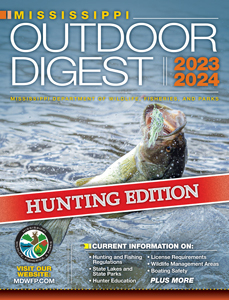Turkey Tagging Coming in Spring 2025
Mississippi turkey hunters must attach harvest tags to all legally taken wild turkeys beginning in the 2025 spring season.
While the process will be new to many Mississippians, it should be familiar to those who have spent much time hunting out of state; nearly three-quarters of states with huntable turkey populations require some form of tagging. This new responsibility will address hunters’ concerns by ensuring greater compliance with bag limits and existing harvest reporting requirements.
Acquisition of turkey tags will be straightforward and required of all hunters, regardless of license exemption status. Tags may be acquired through any avenue used to purchase a hunting license. If done online or via the Mississippi Wildlife, Fisheries, and Parks’ (MDWFP) mobile app, tags will be shipped directly to you. Alternatively, they will be able to be printed directly by any point-of-sale license vendor.
Utilizing tagging as a conservation and management tool will allow hunters and the MDWFP to protect the wild turkey resource more effectively for future generations! For more information, visit www.mdwfp.com/turkey.
WMA Changes
The Commission for Mississippi Wildlife, Fisheries, and Parks approved the creation of Calling Panther Wildlife Management Area (WMA) in Copiah County at its May meeting.
The newest WMA will have permitted turkey hunts, permitted archery hunts, and squirrel hunts (squirrel hunts will be in February only).
The deer hunts are archery-only and take place from Sept. 30 through Jan. 31. Hunters will submit applications in a random drawing and will be drawn for the Thursday-Sunday hunts. The application period for draw hunts is the same as it will be for all WMAs (Aug. 1-31).
Turkey hunts will take place on weekends during the statewide season and are youth-only. Two hunters will be drawn for each hunt. The application period is Jan. 15-Feb. 15.
Name changes to two other WMAs also were approved:
- Tuscumbia WMA to Harvey Moss WMA at Tuscumbia
- Caney Creek WMA to Richard L. “Dick” Livingston and Dale O. Windham WMA at Caney Creek
Electric Bikes
Electric bicycles (E-bikes) are becoming increasingly popular for recreational use on trails and parks. However, it is important to note that each park has its own rules and regulations regarding electric bicycles.
On most WMAs, E-bikes can be used on designated ATV trails. Off-road use is allowed only for the retrieval of harvested deer and hogs. On WMAs where electric bicycles are allowed, these bikes now can be ridden on marked foot-traffic trails only by users 65 and older. Considered a motorized vehicle, similar to ATVs, E-bikes with a cart on the back have been helpful with game retrieval for senior adults. E-bikes still may not be ridden on any leveed roads or trails.
Tupelo Office
MDWFP has reopened its office at Elvis Presley Lake in Tupelo. The office is fully staffed with MDWFP employees and open from 8 a.m. to 5 p.m., Monday-Friday. In addition to staffing from Wildlife, Fisheries, and Law Enforcement bureaus, there will also be a point-of-sale system in place where the public can purchase their licenses and permits and renew their boat registrations. Elvis Presley Lake and the adjacent campground will remain closed while undergoing renovations. For more information, please call (662) 840-5172.

